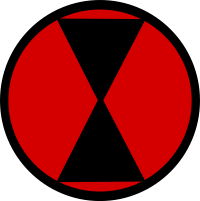7th Infantry Division (United States)
|
||||||||||||||||||||||||||||||||||||
|
||||||||||||||||||||||||||||||||||||
|
||||||||||||||||||||||||||||||||||||
The 7th Infantry Division was an infantry division of the United States Army. It was activated in December 1917 in World War I, deactivated in August 2006 following the end of the Cold War, and based at Fort Ord, California for most of its history. Although elements of the division saw brief active service in World War I, it is best known for its participation in the Pacific Ocean theater of World War II where it took heavy casualties engaging the Imperial Japanese Army in the Aleutian Islands, Leyte, and Okinawa.
Following the Japanese surrender in 1945, the division was stationed in Japan and Korea, and with the outbreak of the Korean War in 1950 was one of the first units in action. It took part in the Inchon Landings and the advance north until Chinese forces counter-attacked and almost overwhelmed the scattered division. The 7th later went on to fight in the Battle of Pork Chop Hill and the Battle of Old Baldy.
After the Korean War ended, the division returned to the United States. In the late 1980s, it briefly saw action overseas in Operation Golden Pheasant in Honduras and Operation Just Cause in Panama. In the early 1990s, it provided domestic support to the civil authorities in Operation Green Sweep and during the 1992 Los Angeles Riots. The division's final role was as a training and evaluation unit for Army National Guard brigades, which it undertook until its deactivation in 2006. Because of its extensive combat history, the division is highly decorated, and has been featured numerous times in American popular culture.
Contents |
History
World War I
The 7th Infantry Division was first raised during World War One and activated on December 6, 1917 as the 7th Division of the regular army at Camp Wheeler, Georgia.[2] One month later, it prepared to deploy to Europe as a part of the American Expeditionary Force.[2] Two subordinate brigades were assigned to the division, the 13th Infantry Brigade and the 14th Infantry Brigade.[3] Most of the division sailed to Europe aboard the SS Leviathan.[4]
While on the Western Front, the 7th did not see action in any engagements at full divisional strength, though its infantry and reconnaissance elements engaged German forces.[4] On October 11, 1918, it first came under shell fire and later, at Saint-Mihiel, came under chemical attack.[4] Elements of the 7th probed up toward Prény near the Moselle River, capturing positions and driving German forces out of the region.[4] It was around this time that the division first received its shoulder sleeve insignia.[5]
In early November, the 7th began preparing for an assault on the Hindenburg Line as part of the Second Army.[4] The division launched a reconnaissance in force on the Voëvre plain but the main assault was never mounted because hostilities ended on November 11, 1918 with the signing of the armistice.[4] During its 33 days on the front line, the 7th Division took 1,988 casualties,[4] including 204 killed in action and 1,505 wounded in action.[6] and was awarded a campaign streamer for Lorraine.[2] During the ensuing year, the division performed occupation duties as it began preparations to return to the continental United States.[7] The 7th Division returned to the United States in late 1919, and was gradually demobilized at Camp George G. Meade, Maryland[4] until on September 22, 1921, it was inactivated.[2]
World War II
On July 1, 1940, the division was reactivated at Camp Ord, California,[2] under the command of Major General Joseph W. Stilwell.[4] The 12th and 13th Brigades did not reactivate as part of an army-wide elimination of brigade commands within its divisions. The division was instead centered around three infantry regiments; the 17th Infantry Regiment,[8] the 32nd Infantry Regiment,[8] and the 53rd Infantry Regiment.[4] Also assigned to the division were the 31st, 48th, 49th and 57th Field Artillery Battalions, as well as the 7th Signal Company, the 707th Ordnance Company, the 7th Quartermaster Company, the 7th Reconnaissance Troop, the 13th Engineer Battalion, the 7th Medical Battalion, and the 7th Counter Intelligence Detachment.[8] Most of the troops in the division were selective service soldiers, chosen as a part of the US Army's first peacetime military draft.[4]

The 7th Infantry Division was assigned to III Corps of the Fourth United States Army,[4] and that year it was sent to Oregon for tactical maneuvers. Division units also practiced boat loading at the Monterey Wharf and amphibious assault techniques at the Salinas River in California.[4] With the Japanese attack of Pearl Harbor, the division was sent to Camp San Luis Obispo to continue its training as a combat division.[4] The 53rd Infantry Regiment was removed from the 7th Division and replaced with the 159th Infantry Regiment, newly deployed from the California Army National Guard.[4] For the early parts of the war, the division participated mainly in construction and training roles. On April 9, 1942, the division was formally redesignated as the 7th Motorized Division.[2] It began training in the Mojave Desert in preparation for deployment to the African theater.[4] However, it was again designated the 7th Infantry Division on January 1, 1943,[2] when the motorized equipment was removed from the unit and it became a light infantry division once more. It began rigorous amphibious assault training under US Marines from the Fleet Marine Force, before being deployed to fight in the Pacific theater instead of Africa.[4] General Holland Smith oversaw the unit's training.[9]
Aleutian Islands
Elements of the 7th Infantry Division first saw combat in the amphibious assault on Attu Island, the western-most Japanese entrenchment in the Aleutian islands chain. Elements landed on May 11, 1943,[10] spearheaded by the 17th Infantry Regiment, and fought an intense battle over the tundra against strong Japanese resistance.[6] The fight for the island culminated in a battle at Chichagof Harbor, when the division destroyed all Japanese resistance on the island[6] on May 29, after a suicidal Japanese bayonet charge.[11] During its first fight of the war, 600 soldiers of the division were killed, while killing 2,351 Japanese and taking 28 prisoners.[11] After American forces secured the island chain, the 159th Infantry Regiment was ordered to stay on the island, and the 184th Infantry Regiment took its place as the 7th Division's third infantry regiment. The 184th Infantry would remain with the division until the end of the war.[4] The 159th Infantry Regiment would stay on the island for some time longer until returning to the United States, where it would remain until the end of the war.
American forces then began preparing to move against nearby Kiska island, termed Operation Cottage, the final fight in the Aleutian islands campaign.[11] In August 1943, elements of the 7th Infantry Division took part in an amphibious assault on Kiska with a brigade from the 6th Canadian Infantry Division, only to find the island deserted by the Japanese.[6] It was later discovered that the Japanese had withdrawn their 5,000-soldier garrison during the night of July 28, under cover of fog.[11]
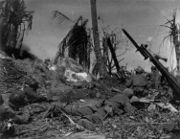
Marshall Islands
After the campaign, the division moved to Hawaii where it trained in new amphibious assault techniques on the island of Maui, before returning to Schofield Barracks on Oahu for brief leave. It was reassigned to V Amphibious Corps, a US Marine Corps command.[12] The division left Pearl Harbor on January 22, 1944, for an offensive on Japanese territory.[4] On January 30, 1944, the division landed on islands in the Kwajalein Atoll in conjunction with the 4th Marine Division,[13] code named Operation Flintlock.[14] The 7th Division landed on the namesake island while the 4th Marine Division forces struck the outlying islands of Roi and Namur.[15] The Division made landfall on the western beaches of the island at 0930 on February 1.[16] It advanced halfway through the island by nightfall the next day, and reached the eastern shore at 1335 hours on February 4, having wrested the island from the Japanese.[16] The victory put V Amphibious Corps in control of all 47 islands in the atoll. The 7th Infantry Division suffered 176 killed and 767 wounded.[4] On February 7, the division departed the atoll and returned to Schofield Barracks.[4]
Elements took part in the capture of Engebi in the Eniwetok Atoll on February 18, 1944, code named Operation Catchpole. Because of the speed and success of the attack on Kwajalein, the attack was undertaken several months ahead of schedule.[14] After a week of fighting, the division secured the islands of the atoll.[17] The division then returned to Hawaii to continue training. There, in June 1944, General Douglas MacArthur and President Franklin Roosevelt personally reviewed the division.[7] In September of that year it secured Yap Island. Within a month, the division defeated the Japanese on the island and prepared to join the campaign to retake the Philippines.[7]
Leyte

The 7th Infantry Division left Hawaii on October 11, heading for Leyte.[7] At this time it was under the command of XXIV Corps of the Sixth United States Army.[18] On October 20, 1944, the division made an assault landing at Dulag, Leyte,[19] initially only encountering light resistance.[20] Following a defeat at sea on October 26, the Japanese launched a large, uncoordinated counteroffensive on the Sixth Army.[21] After heavy fighting, the 184th Infantry secured airstrips at Dulag, while the 17th Infantry secured San Pablo, and the 32nd Infantry took Buri.[17] The 17th Infantry troops moved north to take Dagami on October 29, in intense jungle warfare that produced high casualties.[17] The division then shifted to the west coast of Leyte on November 25 and attacked north toward Ormoc, securing Valencia on December 25.[17] An amphibious landing by the 77th Infantry Division effected the capture of Ormoc on December 31, 1944.[17] The 7th Infantry Division joined in the occupation of the city, and engaged the 26th Japanese Infantry Division, which had been holding up the advance of the 11th Airborne Division. The 7th Division's attack was successful in allowing the 11th Airborne Division to move through,[4] however, Japanese forces proved difficult to drive out of the area. As such, operations to secure Leyte continued until early February, 1945.[17] Afterward, the division began training for an invasion of the Ryukyu island chain throughout March 1945.[7] It was relieved from the Sixth Army, which went on to attack Luzon.[22]
Okinawa
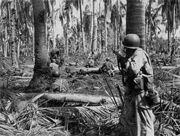
The division was reassigned to XXIV Corps, Tenth United States Army, a newly formed command, and began preparations for the assault on Okinawa.[23] The Battle of Okinawa began on April 1, 1945, L-Day, when the 7th Infantry Division participated in an assault landing south of Hagushi, Okinawa alongside the 96th Infantry Division, and the 1st, and 6th Marine Divisions.[24][25] of III Amphibious Corps.[26] These divisions spearheaded an assault that would eventually land 250,000 men ashore.[27] The 7th Division quickly moved to Kadena, taking its airfield, and drove from the west to the east coast of the island on the first day.[28] The division then moved south, encountering stiff resistance from fortifications at Shuri a few days later.[26] The Japanese had moved 90 tanks, much of their artillery, and heavy weapons away from the beaches and into this region.[29] Eventually, XXIV Corps destroyed the defenses after a 51-day battle in the hills of southern Okinawa,[17] which was complicated by harsh weather and terrain.[26] During the operation, the division was bombarded with tens of thousands of rounds of field artillery fire, encountering Japanese armed with spears as it continued its fight across the island.[30] Japanese also fought using irregular warfare techniques, relying on hidden cave systems, snipers, and small-unit ambushes to delay the advancing 7th Infantry Division.[31] After the fight, the division began capturing large numbers of Japanese prisoners for the first time in the war, due to low morale, high casualties, and poor equipment.[32] It fought for five continuous days to secure areas around the Nakagusuku Wan and Skyline Ridge. The division also secured Hill 178 in the fighting.[33] It then moved to Kochi Ridge, securing it after a two week battle.[4] After another 39 days of continuous fighting, the 7th Infantry Division was sent into reserve, having suffered heavy casualties.[4]
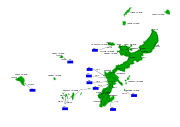
After the 96th Infantry Division secured Conical Hill, the 7th Infantry Division returned to the line. It pushed into positions on the southern Ozato Mura hills, where Japanese resistance was heaviest.[34] It was placed on the extreme left flank of the Tenth Army, taking the Ghinen peninsula, Sashiki, and Hanagusuku, fending off a series of Japanese counterattacks.[35] Despite heavy Japanese resistance and prolonged bad weather, the division continued its advance until June 21, 1945, when the battle ended, having seen 82 days of combat.[4] The island and surrendering troops were secured by the next day.[27] During the Battle of Okinawa, the soldiers of the 7th Infantry Division killed between 25,000 and 28,000 Japanese soldiers and took 4,584 prisoners.[4] Balanced against this, the 7th Division suffered 1,116 killed, and around 6,000 wounded, to make its total casualties for World War II 8,135[4] during 208 days of combat.[6] The division was slated to participate in Operation Downfall as a part of XXIV Corps under the First United States Army, but these plans were scrapped after the Japanese surrendered following the use of nuclear weapons on Hiroshima and Nagasaki.[36]
During World War II, soldiers of the 7th Infantry Division won three Medals of Honor, 26 Distinguished Service Crosses, one Distinguished Service Medal, 982 Silver Star Medals, 33 Legion of Merit Medals, 50 Soldier's Medals, 3,853 Bronze Star Medals, and 178 Air Medals.[6] The division received four campaign streamers and a Philippine Presidential Unit Citation during the war.[2][6]
Occupation of Japan
A few days after V-J Day, the division moved to Korea to accept the surrender of the Japanese Army in South Korea.[17] After the war, the division served as an occupation force in Korea and Japan. Seven thousand, five hundred members of the unit returned to the United States, and the 184th Infantry Regiment was reassigned to the California Army National Guard, cutting the division to half its combat strength.[4] To replace it, the 31st Infantry Regiment was assigned to the division.[4] The 7th Infantry Division remained on occupation duty in Korea patrolling the 38th parallel until 1948, when it was reassigned to occupation duty in Japan, in charge of northern Honshu and all of Hokkaido.[4][37] During this time, the US Army underwent a drastic reduction in size. At the end of World War II, it contained 89 divisions, but by 1950, the 7th Infantry Division was one of only 10 active divisions in the force.[38] It was one of four understrength divisions on occupation duty in Japan alongside the 1st Cavalry Division, 24th Infantry Division, and 25th Infantry Division, all under control of the Eighth United States Army.[39][40]
Korean War
At the outbreak of the Korean War in 1950, the 7th Infantry Division commander, Major General David G. Barr, assembled the division at Camp Fuji near Mount Fuji.[4] The division was already depleted due to post-war shortages of men and equipment[39] and further depleted as it sent large numbers of reinforcements to strengthen the 25th Infantry Division and 1st Cavalry Division, which were sent into combat in South Korea in July.[41] The division was reduced to 9,000 men, half of its wartime strength.[42] To replenish the ranks of the understrength division, the Republic of Korea assigned over 8,600 poorly trained Korean soldiers to the division.[43] With the addition of priority reinforcements from the US, the division was eventually increased to 25,000 when it entered combat.[44] Also fighting with the 7th Infantry Division for much of the war were members of the three successive Kagnew Battalions sent by Emperor Haile Sellassie of Ethiopia as part of the United Nations forces.[45]
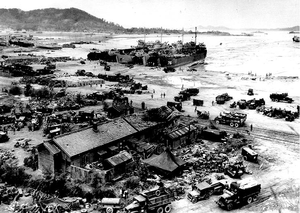
The division paired with the 1st Marine Division under X Corps to participate in the Inchon Landing,[43] code named Operation Chromite.[46] The two divisions would be supported by the 3rd Infantry Division in reserve.[46] Supported by 230 ships of the US Navy,[47] X Corps began landing at Incheon on September 7, 1950, catching the North Korean Army by surprise.[48] the 7th Infantry Division began landing on September 18,[49] after the 1st Marine Division, securing its right flank.[50] X Corps quickly advanced to Seoul, and the 1st Marine Division attacked the 20,000 defenders of the city from the north and southwest,[51] while the 7th Infantry Division's 32nd Infantry Regiment attacked from the southeast.[52] The 31st Infantry followed behind.[53][54] Seoul fell to the Americans after suffering moderate casualties, particularly for the Marines.[55] The division then began advancing south to cut off North Korean supply routes.[56][57] The 32nd Infantry crossed the Han River on September 25 to create a bridgehead,[58][59] and the next day, the division advanced to 30 miles south of Seoul[60] and linked up with the 1st Cavalry Division at Osan.[52] Radio miscommunication and attack from nearby North Korean forces caused a miscommunication, the soldiers of the 1st Cavalry and 7th Infantry briefly engaged in a small-arms firefight with one another, unable to communicate.[61] Seoul was liberated one day later with the help of air assets from the 1st Cavalry Division.[62] The combined forces of the Eighth Army cut off and captured retreating North Korean troops from Pusan.[63] X Corps was kept separate from the rest of the Eighth Army to avoid placing a burden on the logistical system.[64] It withdrew back through the ports of Inchon and Pusan, as part of a plan to conduct another amphibious assault in North Korea.[65] The entire battle for Inchon and Seoul cost the division 106 killed, 411 wounded and 57 missing American soldiers, and 43 killed, 102 wounded South Korean soldiers.[66]
By mid-October, the North Korean army had been almost completely destroyed, and US President Harry S. Truman ordered General MacArthur to advance all units into Korea as quickly as possible to end the war.[65] The 7th Infantry Division, still part of X Corps, participated in a second amphibious assault on the east coast of North Korea, landing at Wonsan on October 26,[67] and Iwon on October 29.[65] The landing was delayed due to the presence of mines, and by the time X Corps arrived, South Korean forces were already occupying the ports.[68] The division advanced to Hyesanjin, on the border with Manchuria by the Yalu River, one of the northernmost advances for United Nations soldiers of the war. Much of X Corps followed behind.[65] On November 21, the 17th Infantry reached the bank of the Yalu river.[69][70] The advance went quickly for the 7th Infantry Division and South Korean troops while the Marines were not able to advance as quickly.[71] The division halted its advance until November 24 while other units of the Eighth Army's IX Corps and South Korean II Corps caught up and supply lines were established.[72] During this time, the 7th Division's regiments were spread out on the front line. The 31st Infantry Regiment remained at the Chosin Reservoir with the 1st Marine Division while the 32nd and 17th Infantry Regiments were much further to the northeast, closer to the South Korean I Corps.[73] It was during this time that the division was served by a new type of unit, the 1st Mobile Army Surgical Hospital (M.A.S.H.).[74]
Chinese intervention
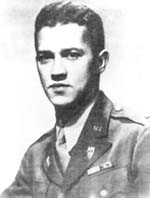
On November 25, Chinese forces entered the war against the United Nations, advancing across the Manchurian border and attacking the Eighth Army's IX Corps and South Korean II Corps in the west and X Corps in the east.[72] X Corps found itself under attack from the 20th, 26th and 27th Chinese field armies, commanding a total of 12 divisions.[75] During the furious action that followed, the 7th Infantry Division's spread out regiments were unable to resist the overwhelming Chinese forces.[76] Three of the Division's infantry battalions were attacked from all sides the next day.[77] 1st Battalion, 32nd Infantry (nicknamed Task Force Faith) was trapped with two other battalions[78] by the 80th and 81st Chinese infantry divisions from the 27th Field Army. In the subsequent Battle of Chosin Reservoir, the three battalions were destroyed by overwhelming Chinese forces[75] suffering over 2,000 casualties.[79] The 31st Infantry suffered heavy casualties trying to fight back the Chinese forces further north, but the 17th Infantry was spared of heavy attack,[80] retreating along the Korean coastline, out of range of the offensive.[81] By the time X Corps ordered a retreat, most of the 7th Infantry Division, save the 17th Infantry Regiment, had suffered 40 percent casualties.[82] The scattered elements of the division saw repeated attacks as they attempted to withdrawal to the port of Hungnam in December 1950.[83] These attacks cost the division another 100 killed before it was fully evacuated.[84] The division suffered 2,657 killed and 354 wounded during the retreat. Most of the dead were members of Task Force Faith.[69]
The division returned to the front lines in early 1951, spearheaded by the 17th Infantry, which had suffered the fewest casualties from the Chinese offensive. Division elements advanced through Tangyang in South Korea, and blocking enemy offensives from the northwest.[85] The division reached full strength and saw action around Cheehon, Chungju, and Pyongchang as part of an effort to push the North Korean and Chinese forces back above the 38th parallel and away from Seoul.[86] The 7th Infantry Division engaged in a series of successful "limited objective" attacks in the early weeks of February, a series of small unit attacks and ambushes between the two sides.[87] By the end of the month the 17th Infantry was driving against a ridge near the village of Maltari.[4] It would continue slowly advancing and clearing enemy hilltop positions through April.[88] By April the entire Eighth Army was advancing north as one line stretching across the peninsula, reaching the 38th parallel by May.[89] The division, assigned to IX Corps, then assaulted and fought a fierce three-day battle culminating with the recapture of the terrain that had been lost near the Hwachon Reservoir just over the 38th parallel in North Korea. In capturing the town bordering on the reservoir it cut off thousands of enemy troops.[90] The division fought on the front lines until June 1951 when it was assigned to the reserve for a brief rest and refitting.[4]
Stalemate
When the division returned to the lines in October, after another assignment in reserve, it moved to the Heartbreak Ridge sector recently vacated by the 2nd Infantry Division, where it was supported by the 3rd Infantry Division and 1st Cavalry Division.[91] During this new deployment the division fought in the Battle for Heartbreak Ridge, to take an area of staging grounds for the Korean and Chinese armies.[7] It remained static in the region until February 23, 1952 when it was sent into reserve and relieved by the 25th Infantry Division.[92] The next year saw the 7th Division engaged in an extended campaign for nearby land, the Battle of Old Baldy.[7] The 7th Division continued to defend "Line Missouri" through September 1952, though it became known as the "Static Line" as UN forces made few meaningful gains in the time.[4]
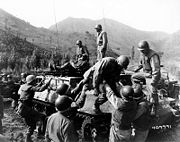
The 7th Infantry Division's Operation Showdown launched in the early morning hours of October 14, 1952, with the 31st Infantry and 32nd Infantry at the head of the attack. The target of the assault was the Triangle Hill complex northeast of Kumhwa.[93] The 7th Infantry Division remained in the Triangle Hill area until the end of October, when it was relieved by the 25th Infantry Division. The 7th Infantry Division was highly praised by commanders for its tenacity through the fight.[4]
The division continued patrol activity around Old Baldy Hill and Pork Chop Hill into 1953, digging tunnels and building a network of outposts and bunkers on and around the hill.[94] In April, the North Korean Army began stepping up offensive operations against UN forces. During the Battle of Porkchop Hill, the Chinese 67th and 141st divisions overran Pork Chop Hill using massed infantry and artillery fire.[95] The hill had been under the control of the 31st Infantry.[96] The 31st counterattacked with reinforcements from the 17th Infantry and recaptured the area the next day. On July 6 the North Koreans and Chinese launched a determined attack against Pork Chop resulting in five days of fierce fighting with few meaningful results.[97] By the end of July, five infantry battalions from the 31st and 17th were defending the hill, while a Chinese division was in position to attack it.[98] During this standoff, the UN ordered the 7th Infantry Division to retreat from the hill in preparation for an armistice, which would end major hostilities.[99]
During the Korean War, the division saw a total of 850 days of combat, suffering 15,126 casualties, including 3,905 killed in action and 10,858 wounded.[100] For the next few years, the division remained on defensive duty along the 38th parallel, under the command of the Eighth Army.[100]
Cold War Era
From 1953 to 1971, the 7th Infantry Division defended the Korean Demilitarized Zone. Its main garrison was Camp Casey, South Korea.[100] During these occupation duties, the division saw a complete reorganization in compliance with the Reorganization Objective Army Divisions plan.[3] The division's former headquarters company grew into the 1st Brigade, 7th Infantry Division while the 13th Infantry Brigade was reactivated as the 2nd Brigade, 7th Infantry Division.[3] The 14th Infantry Brigade was reactivated as the 3rd Brigade, 7th Infantry Division.[101] In 1965 the division received its distinctive unit insignia, which alluded to its history during the Korean War.[5] On April 2, 1971, the division returned to the United States and was inactivated at Fort Lewis, Washington.[2]
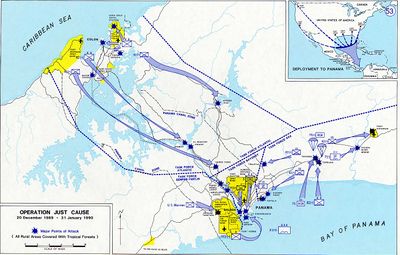
In October 1974 the 7th reactivated at its former garrison, Fort Ord.[2] The unit did not see any action in Vietnam or during the post-war era, but was tasked to keep a close watch on South American developments. It trained at Fort Ord, Camp Roberts, Fort Hunter Liggett and Fort Irwin. In September to October 1984, several infantry and artillery regiments deployed to Japan to participate in Michinoku '84, a joint readiness training exercise conducted with their GSDF. On October 1, 1985 the division was redesignated as the 7th Infantry Division (Light), organized again as a light infantry division.[7] It was the first US division specially designed as such. The various battalions of the 17th, 31st, and 32nd regiments moved from the division, replaced by battalions from other regiments, including battalions from the 21st Infantry Regiment, the 27th Infantry Regiment, and the 9th Infantry Regiment. The 27th and 9th infantry regiments participated in Operation Golden Pheasant in Honduras.[102]
In 1989 the 7th Infantry Division participated in Operation Just Cause in Panama, briefly occupying the country in conjunction with the 82nd Airborne Division. Elements of the 7th Infantry Division landed in the northern areas of Colón Province, Panama, securing the Coco Solo Naval Station, Fort Espinar, France Field, and Colon while the 82nd Airborne and US Marines fought in the more heavily populated southern region.[102] Once Panama City was under U.S. control, the 82nd quickly re-deployed and left the city under the control of the 7th Division's 9th Infantry Regiment until after the capture of Manuel Noriega.
In 1991 the Base Realignment and Closure Commission recommended the closing of Fort Ord due to the escalating cost of living on the central California coastline. By 1994, the Fort Ord closed the 7th Infantry Division subsequently relocated to Fort Lewis, Washington.[103] Elements of the division (the 2nd Brigade, to include its Headquarters and Headquarters Company, the 3rd Brigade's 3rd Battalion 17th Infantry Regiment and other assigned military police companies) participated in one final mission in the United States before inactivation; quelling the 1992 Los Angeles Riots, called Operation Garden Plot.[104] The division's soldiers patrolled the streets of Los Angeles to act as crowd control and supported the Los Angeles Police Department and California National Guard in preventing the riots from escalating in violence.[102]
In 1993 the division was slated to be inactivated as part of the post-Cold War drawdown of the US Army. The 1st Brigade relocated to Fort Lewis and was later reflagged as the 2nd Brigade of the 2nd Infantry Division while the 2nd Brigade and the 3rd Brigade of the 7th was inactivated at Fort Ord. The division headquarters was formally inactivated on June 16, 1994 at Fort Lewis.[2]
Training command
In the wake of the Cold War, the US Army considered new options for the integration and organization of active duty, Army Reserve and Army National Guard units in training and deployment. Two division headquarters activated in the active duty component for training National Guard units. The 7th Infantry Division and the 24th Infantry Division headquarters were selected.[102] The subordinate brigades of the divisions did not activate so they could not be deployed as divisions, however their active duty status would allow the headquarters to focus on the national guard units under them full-time.[105]
The headquarters company of the 7th Infantry Division (Light) formally reactivated on June 4, 1999, at Fort Carson, Colorado, as the first Active Component/Reserve Component division.[2] The reserve formations that made up the 7th Infantry Division included the 39th Infantry Brigade Combat Team of the Arkansas National Guard, the 41st Infantry Brigade Combat Team of the Oregon National Guard and the 45th Infantry Brigade Combat Team of the Oklahoma National Guard.[102] Fort Carson became the new headquarters for the division.[102]
The division headquarters also provided training assistance in preparation for small-scale National Guard operations, Joint Readiness Training Center rotations, leadership training for National Guard commanders, and annual summer training for the three brigades.[102] As a part of this commitment, the 7th Infantry Division headquarters would deploy a command element to serve as higher headquarters for large-scale training and field exercises, evaluating and coordinating the units as they trained. It would also conduct quarterly status checks with the three brigades to discuss readiness and resource issues affecting those units, ensuring that they were at peak performance should they be needed.[102]
To expand upon the concept of Reserve component and National Guard components, the First Army activated Division East and Division West, two commands responsible for training reserve units' readiness and mobilization exercises. Division West, activated at Fort Carson.[106] This transformation was part of an overall restructuring of the US Army to streamline the organizations overseeing training. The Division West took control of reserve units in 21 states west of the Mississippi River, eliminating the need for the 7th Infantry Division headquarters.[106] As such it was subsequently deactivated for the last time on August 22, 2006 at Fort Carson.[2]
Though it was inactivated, the division was identified as the highest priority inactive division in the United States Army Center of Military History's lineage scheme due to its numerous accolades and long history. All of the division's flags and heraldic items were moved to the National Infantry Museum at Fort Benning, Georgia following its inactivation.[107] Should the US Army activate another division in the future, the Center will most likely suggest it be designated the 7th Infantry Division.[108]
Honors
The 7th Infantry Division was awarded one campaign streamer in World War I, four campaign streamers and two unit decorations in World War II, and ten campaign streamers and two unit decorations in the Korean War, for a total of fifteen campaign streamers and four unit decorations in its operational history.[2]
Unit decorations
| Ribbon | Award | Year | Notes |
|---|---|---|---|
| Philippine Presidential Unit Citation | 1944–1945 | for service in the Philippines during World War II | |
| Republic of Korea Presidential Unit Citation | 1950 | for the Inchon Landings | |
| Republic of Korea Presidential Unit Citation | 1950–1953 | for service in Korea | |
| Republic of Korea Presidential Unit Citation | 1945–1948; 1953–1971 | for service in Korea |
Campaign streamers
| Conflict | Streamer | Year(s) |
|---|---|---|
| World War I | Lorraine | 1918 |
| World War II | Aleutian Islands | 1943 |
| World War II | Eastern Mandates | 1944 |
| World War II | Leyte | 1945 |
| World War II | Ryukyus | 1945 |
| Korean War | UN Defensive | 1950 |
| Korean War | UN Offensive | 1950 |
| Korean War | CCF Intervention | 1950 |
| Korean War | First UN Counteroffensive | 1950 |
| Korean War | CCF Spring Offensive | 1951 |
| Korean War | UN Summer-Fall Offensive | 1951 |
| Korean War | Second Korean Winter | 1951–1952 |
| Korean War | Korea, Summer-Fall 1952 | 1952 |
| Korean War | Third Korean Winter | 1952–1953 |
| Korean War | Korea, Summer 1953 | 1953 |
Legacy
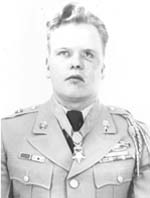
With its long history, the 7th Infantry Division has been featured several times in popular culture. The 7th Infantry Division appeared in Tom Clancy's novel Clear and Present Danger.[109] The division is also featured in Ranger: Simulation of Modern Patrolling Operations, a video game developed by US Army veterans.[110]
People who served in the 7th Infantry Division and later went on to achieve notability in the military or other fields include Heisman Trophy winner Pete Dawkins,[111] future US Air Force General and aviation pioneer Ira C. Eaker,[112] astronomer Philip Fox,[113] former US Congressman Dan Rostenkowski, and Young-Oak Kim the first minority commander of a U.S. Army combat battalion.[114]
Additionally, many high ranking generals served in the 7th Infantry Division for a time before moving on to higher commands, including Generals William F. Kernan,[115] Arthur E. Brown, Jr.,[116] Henry I. Hodes,[117] Andrew P. O'Meara,[118] William R. Richardson, Edwin H. Burba, Jr.,[119] and Berton E. Spivy, Jr.,[120] as well as Lieutenant Generals Robert Arter, Robert Sink,[121] Claire E. Hutchin, Jr.[122] and Scott C. Black[123] also served with the division, along with Major Generals Galen B. Jackman[124] and Jens A. Doe.[125]
Sixteen men were awarded the Medal of Honor for actions while serving with the 7th Infantry Division. Three of these were awarded during World War II—Leonard C. Brostrom, John F. Thorson, and Joe P. Martinez[126][127][128][129]—while another thirteen members of the division received the Medal of Honor for their actions during the Korean War: Charles H. Barker, Raymond Harvey, Einar H. Ingman, Jr., Anthony T. Kahoʻohanohano, William F. Lyell, Joseph C. Rodriguez, Richard Thomas Shea, Jack G. Hanson, Ralph E. Pomeroy, Edward R. Schowalter, Jr., Benjamin F. Wilson, Don C. Faith, Jr., and Daniel D. Schoonover.[130]
References
- ↑ 1.0 1.1 "Regular Army / Army Reserve Special Designation Listing". United States Army Center of Military History. 2009. http://www.history.army.mil/html/forcestruc/spdes-123-ra_ar.html. Retrieved 2009-04-27.
- ↑ 2.00 2.01 2.02 2.03 2.04 2.05 2.06 2.07 2.08 2.09 2.10 2.11 2.12 2.13 "Lineage and Honors Information: 7th Infantry Division". United States Army Center of Military History. 2009. http://www.history.army.mil/html/forcestruc/lineages/branches/div/007id.htm. Retrieved 2009-04-27.
- ↑ 3.0 3.1 3.2 McGrath, p. 188.
- ↑ 4.00 4.01 4.02 4.03 4.04 4.05 4.06 4.07 4.08 4.09 4.10 4.11 4.12 4.13 4.14 4.15 4.16 4.17 4.18 4.19 4.20 4.21 4.22 4.23 4.24 4.25 4.26 4.27 4.28 4.29 4.30 4.31 4.32 4.33 4.34 "7th Infantry Division Homepage: History". 7th Infantry Division. 2003. http://www.carson.army.mil/UNITS/F7ID/F7ID_Historylong.htm. Retrieved 2009-04-27.
- ↑ 5.0 5.1 "The Institute of Heraldry: 7th Infantry Division". The Institute of Heraldry. 2009. http://www.tioh.hqda.pentagon.mil/Inf/07thInfantryDivision.htm. Retrieved 2009-04-27.
- ↑ 6.0 6.1 6.2 6.3 6.4 6.5 6.6 Army Almanac, p. 524.
- ↑ 7.0 7.1 7.2 7.3 7.4 7.5 7.6 7.7 "7th Infantry Division Homepage: Chronological History". 7th Infantry Division. 2003. http://www.carson.army.mil/UNITS/F7ID/F7ID_History.htm. Retrieved 2009-04-27.
- ↑ 8.0 8.1 8.2 Army Almanac, p. 592.
- ↑ "General Holland McTyeire Smith, USMC". Who's Who in Marine Corps History. History Division, United States Marine Corps. http://www.tecom.usmc.mil/HD/Whos_Who/Smith_HM.htm. Retrieved 2007-09-30.
- ↑ Horner, p. 41.
- ↑ 11.0 11.1 11.2 11.3 Horner, p. 42.
- ↑ Rottman, Gordon L. (2002). U.S. Marine Corps World War II Order of Battle — Ground and Air Units in the Pacific War, 1939 - 1945.. Greenwood Press. ISBN 0-313-31906-5.
- ↑ Marshall, S. L. A.; Joseph G. Dawson (2001). Island Victory: The Battle of Kwajalein Atoll. University of Nebraska Press. ISBN 0-8032-8272-9.
- ↑ 14.0 14.1 Marston, p. 169.
- ↑ Pimlott, p. 170.
- ↑ 16.0 16.1 Pimlott, p. 171.
- ↑ 17.0 17.1 17.2 17.3 17.4 17.5 17.6 17.7 Army Almanac, p. 525.
- ↑ Appleman, et. al., p. 26.
- ↑ Horner, p. 56.
- ↑ Horner, p. 57.
- ↑ Horner, p. 59.
- ↑ Horner, p. 60.
- ↑ Appleman, et. al., p. 25
- ↑ Stewart, p. 188.
- ↑ Willmott, p. 190.
- ↑ 26.0 26.1 26.2 Pimlott, p. 208.
- ↑ 27.0 27.1 Horner, p. 64.
- ↑ Pimlott, p. 209.
- ↑ Marston, p. 215.
- ↑ Appleman, et. al., p. 133.
- ↑ Marston, p. 217.
- ↑ Willmott, p. 192.
- ↑ Appleman, et. al., p. 76.
- ↑ Appleman, et. al., p. 105.
- ↑ Appleman, et. al., p. 110.
- ↑ Allen, Thomas B.; Polmar, Norman (1995). Code-Name Downfall. New York: Simon & Schuster. pp. 54. ISBN 0684804069.
- ↑ Alexander, p. 52.
- ↑ Stewart, p. 211.
- ↑ 39.0 39.1 Stewart, p. 222.
- ↑ Catchpole, p. 41.
- ↑ Stewart, p. 225.
- ↑ Alexander, p. 169.
- ↑ 43.0 43.1 Stewart, p. 227.
- ↑ Alexander, p. 170.
- ↑ Varhola, p. 134.
- ↑ 46.0 46.1 Catchpole, p. 39.
- ↑ Alexander, p. 173.
- ↑ Malkasian, p. 25.
- ↑ Alexander, p. 206.
- ↑ Alexander, p. 172.
- ↑ Alexander, p. 214.
- ↑ 52.0 52.1 Malkasian, p. 27.
- ↑ Catchpole, p. 46.
- ↑ Alexander, p. 212.
- ↑ Alexander, p. 215.
- ↑ Varhola, p. 9.
- ↑ Alexander, p. 210.
- ↑ Catchpole, p. 49.
- ↑ Alexander, p. 213.
- ↑ Alexander, p. 223.
- ↑ Alexander, p. 224.
- ↑ Stewart, p. 228.
- ↑ Alexander, p. 249.
- ↑ Stewart, p. 229.
- ↑ 65.0 65.1 65.2 65.3 Stewart, p. 230.
- ↑ Catchpole, p. 52.
- ↑ Malkasian, p. 29.
- ↑ Varhola, p. 10.
- ↑ 69.0 69.1 Varhola, p. 12.
- ↑ Alexander, p. 309.
- ↑ Alexander, p. 307.
- ↑ 72.0 72.1 Stewart, p. 231.
- ↑ Malkasian, p. 31.
- ↑ Catchpole, p. 162.
- ↑ 75.0 75.1 Catchpole, p. 86.
- ↑ Malkasian, p. 34.
- ↑ Alexander, p. 313.
- ↑ Alexander, p. 328.
- ↑ Alexander, p. 366.
- ↑ Stewart, p. 232.
- ↑ Alexander, p. 320.
- ↑ Catchpole, p. 90.
- ↑ Catchpole, p. 92.
- ↑ Alexander, p. 367.
- ↑ Varhola, p. 18.
- ↑ Varhola, p. 19.
- ↑ Alexander, p. 382.
- ↑ Catchpole, p. 114.
- ↑ Alexander, p. 421.
- ↑ Stewart, p. 239.
- ↑ Catchpole, p. 146.
- ↑ Catchpole, p. 166.
- ↑ Varhola, p. 27.
- ↑ Catchpole, p. 302.
- ↑ Varhola, p. 30.
- ↑ Catchpole, p. 300.
- ↑ Stewart, p. 240.
- ↑ Catchpole, p. 306.
- ↑ Catchpole, p. 307.
- ↑ 100.0 100.1 100.2 Varhola, p. 96.
- ↑ McGrath, p. 189
- ↑ 102.0 102.1 102.2 102.3 102.4 102.5 102.6 102.7 "GlobalSecurity.org: 7th Infantry Division". GlobalSecurity. 2003. http://www.globalsecurity.org/military/agency/army/7id.htm. Retrieved 2009-04-27.
- ↑ "GlobalSecurity.org: Fort Ord". GlobalSecurity. 2003. http://www.globalsecurity.org/military/facility/fort-ord.htm. Retrieved 2009-04-27.
- ↑ "GlobalSecurity.org: Operation Garden Plot". GlobalSecurity. 2003. http://www.globalsecurity.org/military/ops/garden_plot.htm. Retrieved 2009-04-27.
- ↑ "Report to the Secretary of Defense (2000)". United States Department of Defense. http://www.dod.mil/execsec/adr2000/army.html. Retrieved 2009-05-03.
- ↑ 106.0 106.1 "First Army Organization". First United States Army Public Affairs. http://www.first.army.mil/mission_statement.htm. Retrieved 2009-11-20.
- ↑ McKenney, p. 21.
- ↑ McKenney, p. 22.
- ↑ Clancy, Tom (1989). Clear and Present Danger. Putnam Press. ISBN ISBN 0-399-13440-9.
- ↑ Ranger: Simulation of Modern Patrolling Operations (Omega Games), 1984.
- ↑ "Pete Dawkins Homepage: Biography". Pete Dawkins. http://www.petedawkins.com/pete.html. Retrieved 2009-05-02.
- ↑ "Arlington Cemetery Biography: Ira C. Eaker". ArlingtonCemetery.net, Michael R. Patterson. http://www.arlingtoncemetery.net/iraeaker.htm. Retrieved 2009-12-09.
- ↑ Menke, David H., "Phillip Fox and the Adler Planetarium", 1987. Planetarium, Vol 16, #1.
- ↑ "The Many Firsts of Col. Young-oak Kim". Digital Chosunilbo (English Edition) : Daily News in English About Korea (Seoul). August 19, 2005. http://english.chosun.com/w21data/html/news/200508/200508190003.html. Retrieved 2008-12-04.
- ↑ "House Armed Services Report: William F. Kernan". United States House of Representatives. http://armed-services.senate.gov/statemnt/1999/990318wk.pdf. Retrieved 2009-12-09.
- ↑ "Interview with Arthur Brown Jr.". United States Department of Defense. http://www.dtic.mil/cgi-bin/GetTRDoc?AD=ADA309374&Location=U2&doc=GetTRDoc.pdf. Retrieved 2009-05-02..
- ↑ Schnabel, James (1972). United States Army in the Korean War: The First Year, From the Invasion to the Beginning of Negotiations. United States Army Center of Military History. p. 337. OCLC 595249.
- ↑ "October 4, 2005 Obituaries". The Washington Post. http://www.washingtonpost.com/wp-dyn/content/article/2005/10/03/AR2005100301729_pf.html. Retrieved 2009-05-02.
- ↑ "Global Payments: Edwin H. Burba, Jr., Director". Global Payments Inc.. http://phx.corporate-ir.net/phoenix.zhtml?c=125339&p=irol-govBio&ID=56473. Retrieved 2009-12-09.
- ↑ "Arlington Cemetery Biography: Berton Spivy". ArlingtonCemetery.net, Michael R. Patterson. http://www.arlingtoncemetery.net/bespivy.htm. Retrieved 2009-12-09.
- ↑ "Fort Bragg: Robert Sink Bio". Fort Bragg Public Affairs Office. http://www.bragg.army.mil/history/Commanders/Commanders%20Pages/sink.htm. Retrieved 2009-12-09.
- ↑ Branham, Charles N. (1955). Charles N. Branham. ed. Biographical Register of the Officers and Graduates of the U.S. Military Academy, Supplement Volume 9.. West Point, New York: The Association of Graduates U.S. Military Academy. pp. 25.
- ↑ "Biography: Scott C. Black". US Army National Guard. http://www.ng.mil/jointstaff/ps/ja/conference/2009/TUESDAY/Black%20-%20Condensed.doc.. Retrieved 2009-12-09.
- ↑ Faler, Brian (January 20, 2005). "General Again has Front Row seat". Washington Post. http://www.washingtonpost.com/wp-dyn/articles/A22252-2005Jan19.html. Retrieved 2009-12-09.
- ↑ McCartney, Wiliam F. (1948). The Jungleers: A History of the 41st Infantry Division. Washington, D.C.: Infantry Journal Press. pp. 190–191. ISBN 1432588176.
- ↑ "Medal of Honor Recipients — World War II (A-F)". United States Army. http://www.history.army.mil/html/moh/wwII-a-f.html. Retrieved 2008-04-24.
- ↑ "Medal of Honor Recipients — World War II (G-L)". United States Army. http://www.history.army.mil/html/moh/wwII-g-l.html. Retrieved 2008-04-24.
- ↑ "Medal of Honor Recipients — World War II (M-S)". United States Army. http://www.history.army.mil/html/moh/wwII-m-s.html. Retrieved 2008-04-24.
- ↑ "Medal of Honor Recipients — World War II (T-Z)". United States Army. http://www.history.army.mil/html/moh/wwII-t-z.html. Retrieved 2008-04-24.
- ↑ "Medal of Honor Recipients — Korean War". United States Army. http://www.history.army.mil/html/moh/koreanwar.html. Retrieved 2008-04-24.
Sources
- Alexander, Bevin (2003). Korea: The First War we Lost. Hippocrene Books. ISBN 978-0781810197.
- Appleman, Roy E.; James M. Burns, Russell A. Gugeler and John Stevens (1960). Okinawa: The Last Battle. Charles E. Tuttle Company. ISBN ASIN B0000CKWNR.
- Army Almanac: A Book of Facts Concerning the Army of the United States. United States Government Printing Office. 1959. ISBN ASIN B0006D8NKK.
- Catchpole, Brian (2001). The Korean War. Robinson Publishing. ISBN 978-1841194134.
- Horner, David (2003). The Second World War, Vol. 1: The Pacific. Osprey Publishing. ISBN 978-0415968454.
- Malkasian, Carter (2001). The Korean War. Osprey Publishing. ISBN 978-1841762821.
- Marston, Daniel (2005). The Pacific War Companion: from Pearl Harbor to Hiroshima. Osprey Publishing. ISBN ASIN B002ARY8KO.
- McGrath, John J. (2004). The Brigade: A History: Its Organization and Employment in the US Army. Combat Studies Institute Press. ISBN 978-1-4404-4915-4.
- McKenney, Janice (1997). Reflagging the Army. United States Army Center of Military History. OCLC 37875549. http://www.history.army.mil/books/Lineage/reflag/fm.htm.
- Pimlott, John (1995). The Historical Atlas of World War II. Henry Holt and Company. ISBN 978-0805039290.
- Stewart, Richard W. (2005). American Military History Volume II: The United States Army in a Global Era, 1917–2003. Army Historical Series. United States Army Center of Military History. ISBN 978-0160725418. http://www.history.army.mil/books/AMH-V2/AMH%20V2/index.htm.
- Varhola, Michael J. (2000). Fire and Ice: The Korean War, 1950-1953. Da Capo Press. ISBN 978-1882810444.
- Willmott, H.P. (2004). The Second World War in the Far East. Smithsonian Books. ISBN 978-1588341921.
External links
- 7th Infantry Division Home Page
- Lineage at the United States Army Center of Military History]
- GlobalSecurity.org: 7th Infantry Division (Light)
- Photo and news archives about the 7th Infantry Division (Light) from 1986-1990
